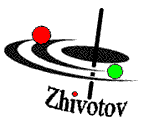 |
N E W S |
|
NEWS |
|
![]() Presentation of a new scientific paper on
Presentation of a new scientific paper on
|
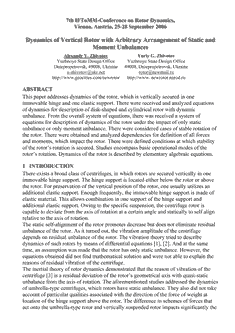 |
|
New
Theory of Rotor Dynamics: Dynamics of Jeffcott Rotor with Moment Unbalance
|
![]() Photos from the 12th World
Congress
Photos from the 12th World
Congress
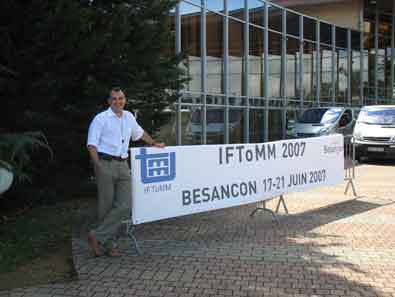 | 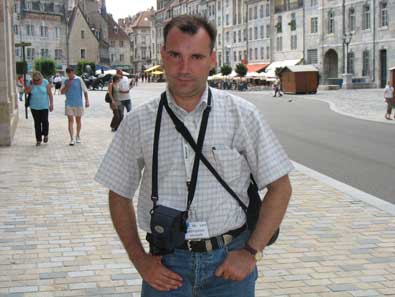 |
Participant of World Congress | |
![]() Presentation of a new scientific paper on
Presentation of a new scientific paper on
|
 |
|
Dynamics
of Vertical Rotor with Arbitrary Arrangement of Static and Moment Unbalances
|
![]() Photos from scientific
conference
Photos from scientific
conference
 |  |
The legendary scientist Ales Tondl and participants of conference | Colleagues
|
 | Parliament house, Vienna, Austria, 26 September 2006
|
Alexandr Yu. Zhivotov
Date: ![]() 4 December 2006.
4 December 2006.
![]() Presentation of a new scientific paper on
Presentation of a new scientific paper on
|
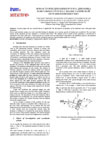 | |
New
Theory of Rotor Dynamics: Dynamics of an Outboard Rotor with a Quasi - Static
Unbalance |
![]() Photos from scientific
conference
Photos from scientific
conference
 |  |
Colleagues On a photo: 1. Mgs. Eng. Damian
Damianov (at the left) 2. Alexandr Zhivotov 3. Dr. Georgi Kamarashev (on the right) Colonel Assoc. Prof., Land Forces Faculty Dean | Scientific discussion On a photo: Dr. Marin Stoytchev, PhD, Prof. and Alexandr Zhivotov |
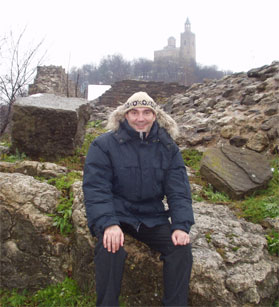 | The "Tsarevets" Hill. The "Patriarchy" Cathedral, Veliko - Tarnovo, BULGARIA
|
Alexandr Yu. Zhivotov
Date: ![]() 15 January 2006.
15 January 2006.
Alexandr Y. Zhivotov & Yuriy G. Zhivotov,
Date: ![]() 31 March 2005.
31 March 2005.
|
U.S. PATENT, INVENTION, SCIENTIFIC PAPERS by Yuriy G. Zhivotov. |
Alexandr Yu. Zhivotov & Yuriy G. Zhivotov,
Date: ![]() 29 June 2004.
29 June 2004.
![]() LIST OF THE SCIENTIFIC PAPERS PUBLISHED
LIST OF THE SCIENTIFIC PAPERS PUBLISHED
By Mr. Zhivotov Alexandr Y., Leading Engineer of Yuzhnoye State Design Office named after M. K. Yangel: www.yuzhnoye.com
(Over a period from 2000 to 2004): Click...
Alexandr Yu. Zhivotov & Yuriy G. Zhivotov,
Date: ![]() 22 June 2004.
22 June 2004.
![]() ISCORMA-2, Reviewer Comments (Paper 405)
ISCORMA-2, Reviewer Comments (Paper 405)
From: "COX, Jeanette" <[email protected]>
To: "Alexandr Zhivotov"<[email protected]>
Date: ![]() Mon, 12 May 2003 10:19:14 -0700
Mon, 12 May 2003 10:19:14 -0700
Theme: ISCORMA-2 Reviewer Comments (405)
Dear Mr. Zhivotov,
The deadline for providing this information to authors
was established as 15 May. Right now I am working hard to provide this.
The person who was in charge of reviews of your three papers said that
the papers are all closely the same with different titles, so only one
paper was sent to reviewers.
The results of the three reviews are that the paper, "New Theory
of Rotor Dynamics: Dynamics of a Rotor of "Umbrella" Type, With
Elastic Support," will be accepted for the conference provided that
the English is much improved and reviewers' comments are incorporated
into the paper. The
reviewer comments follow:
It is a worthwhile research document. I'm not quite sure I have ever seen a paper that has developed the equations of motion for a vertical centrifuge like apparatus, where there is one fixed pin support and one elastic support.
I thought it was particularly interesting how the equations of motion we developed around the using the forces and moments developed as the rotor's CG displaced from the axis of rotation.
This person obviously spent the time to develop and even has some explanation "what ifs" in his paper. This paper was well thought out, definitely conference worthy.
I liked the translation too,
some funny stuff like:
Angles = Corners
Free Body Diagrams = Circuits
___________________
This paper basically derives
the equations of motion for a quite simple rigid-rotor single-disk
two-bearing configuration, with one bearing flexible and the other infinitely
stiff.
This system therefore has two degrees-of-freedom. By assuming an isotropic radial bearing stiffness and single-frequency motion (e.g., synchronous), the motion could be described as a projection onto a single plane, thus reducing the number of degrees-of-freedom to one.
Deriving the equation(s) of motion for this system is thus the equivalent of a fairly straight forward engineering course homework assignment.
Therefore, in this reviewer's opinion, this paper does not make a sufficient contribution to warrant presentation or publication. One is therefore correspondingly astounded by the lead-in title of this paper, "New Theory of Rotor Dynamics".
While the above assessment of this paper is sufficient grounds for its rejection, it is also noted here that even if it were of substantial technical content, which it is not, the English writing is quite hard to read because of many misused words, e.g., "firm body" instead of "rigid body", "corner" instead of "angle", to note just a few of many, i.e., two that the reviewer could figure out and "translate"!
Although of no significance to the worthiness of this paper, it is unusual that the authors give no business or professional affiliation, e.g., company, university, institute, other, but only what appears to be a shared home address.
_______________
The paper develops a dynamic model of a vertical rotor from a force balance. The topic falls within the ISCORMA-2 frame of topics but is not sufficiently developed or unique to merit acceptance in its present form without changes as described below. The authors should also seek professional help to improve the English writing.
Several equations are presented without justification, explanation or reference. Equations 4,5,7, and 13 which are the basis of the paper fall into this category. The dimensions of equations 4 and 5 are not consistent. I question the validity of equation 13 where vector forces are added without regard to direction, notice that the first term is Fkp and the last term is Fy . These forces are orthogonal and coincident yet are merely summed in equation 13. I would also like to. see an explanation for justifying equation 18 as a critical speed.
The organization of the paper is good until section
8 where geometric background is presented rather than the summary and
conclusions one would expect.
________
I hope these comments will help you in preparing your final manuscript, which is due to me no later than 15 June. Prior to that time, I also need to have an extended abstract (no longer than one page), which will be printed in a book to be handed out at the conference. I also need to have a completed copyright form, which I will attach to this e-mail.
Please add page numbers to your paper, and send it to me in .pdf format.
Best regards,
Jeanette Cox
![]() The letter to ISCORMA-2
The letter to ISCORMA-2
From: "Alexandr Zhivotov"<[email protected]>
To: "COX, Jeanette" <[email protected]>
Date: ![]() Thy, 15 May 2003
Thy, 15 May 2003
Theme: Re: ISCORMA-2 Reviewer Comments (405)
Dear Jeanette A. Cox!
We have received your letter from 05.12.2003, which contains comments of Reviewers and the Decision on acceptance of a scientific paper N 405 to listenings on ISCORMA-2. It is the pleasant information. We thank you.
Certainly, remarks of Reviewers will be considered and taken into account in a final scientific paper. Us also interests destinies of two papers N 403 and N 404. These papers are very similar to a paper N 405 on the shape and the text. In it there is nothing surprising as we used a common an inertial method for solving problem of rotors dynamics of a different construction. However the contents of the papers N 403 and N 404 essentially differs from the contents of the paper N 405. The tasks solved in papers N 403 and N 404 essentially differs from the tasks solved in a paper N 405.
In a paper N 404 the rotor, which hangs on a shaft is
investigated. Such rotor is used in centrifugal stands (look a photo).
In a paper N 405 the rotor, which leans on a shaft is investigated. Such
rotor is used in ultracentrifuges.
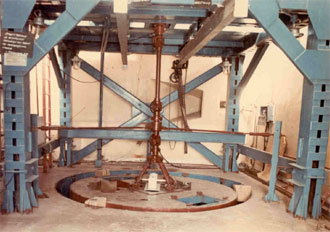
In our scientific papers we aspire not only to acquaint scientists with a new method for the decision of problems of dynamics of a rotor, and also to give decisions of technical problems for engineers who project machines.
Therefore the presentation of all our papers will be useful too much. Pay attention. Method of the Lagrange is the common method for the decision of problems of dynamics of systems with the constant moments of inertia.
Scientific papers in which application of a method for the decision of problems of dynamics of a rotor is described, also are very similar each other.
However the decision of various problems with the help of this method does not interfere with the publication of scientific papers. It is very a pity, that there was a similar misunderstanding. We admit, that misunderstanding can be removed.
We have very big desire that the scientific paper N 404 also has been included in hearings ISCORMA-2.
We assure you that all remarks of the Reviewers made to a paper N 405 will be taken into account in final paper N 404.
Sincerely,
![]() The letter of William J. Anderson
The letter of William J. Anderson
From: [email protected]
To: Alexandr Zhivotov <[email protected]>
Copy: [email protected], [email protected], [email protected]
Theme: Re: rotor dynamics
Dear Alexandr Zhivotov:
I am happy to see your interest in the effects of rotation on vibrating bodies. I worked in this area about 15 years ago with a doctoral student, Howard Gans. We published two papers, as I remember in the AIAA Journal, including centrifugal and Coriolis effects on the vibration of turbine/compressor blades. We went further, and optimized the frequencies by redistributing stiffness and mass properties.
At the time, we found that for turbines rotating in the 35,000 rpm range (typical of General Electric compressors at the time, I believe), the addition of the centrifugal stiffening (called "differential stiffness" by the MSC/Nastran people) caused about a 4% change in rotational frequencies. (These blades are relatively stiff--for helicopter rotors the effects are orders of magnitude of change). When we added Coriolis effects, it caused a further 1% change in frequencies of the blades. This somewhat confirmed the industry usage (as done at Pratt and Whitney) where they included differential stiffness, but not Coriolis effects in their optimization studies.
The only reason we were able to get results was that the MSC/NASTRAN program had built into it part of the necessary ingredients, namely the differential stiffness matrices. (They even have this stiffness for solid elements. It is the first order nonlinear geometric correction.) Secondly, it was possible to do matrix calculations within the MSC/NASTRAN program by using a matrix language called DMAP (Direct Matrix Abstraction Program).
I'm not certain you are finding any new dynamics effects that haven't already been studied numerically. Certainly it would be good to present alternate, analytical formulations. Overall, however, the problem is enormously complicated--to the point of being beyond normal engineering usefulness in design situations.
I am writing to you from home, having retired 2 years ago, and I have all my references at an office where I do consulting (about 24 miles away). As a result, I can't give you my publications on the topic immediately. The first author was Howard Gans, the Journal was AIAA Journal, about 15 years ago. I believe we did two such papers.
Sincerely,
William J. Anderson. Professor Emeritus, University of Michigan Aerospace Dept. Founder, Automated Analysis Corporation (now a division of Belcan Corporation).
We salute participants and organizers of the Eleventh World Congress in
Mechanism and Machine Science!
We publish our scientific paper, which has been intended for representation on the Eleventh World Congress in Mechanism and Machine Science (Tianjin University, Tianjin, China, April 1-4, 2004).
![]() The brief critical review of ability of the vibrating
theory of a rotor dynamics to solve questions of aerodynamic and internal
drag.
The brief critical review of ability of the vibrating
theory of a rotor dynamics to solve questions of aerodynamic and internal
drag.
Dear all! In the theory of vibration there is a concept of viscous friction. Viscous friction is the average value of frontal aerodynamic drag for one cycle of oscillations of a beam.
The concept of viscous friction as average value of aerodynamic or hydraulic drag is entered in the theory of oscillations by artificial way as actual speed of motion of a center of masses of a beam changes from a zero up to the maximal value twice during one cycle of oscillations.
The theory of oscillations counts, that force of frontal aerodynamic drag is proportional to average speed of motion of a center of masses of a beam, as the differential equations of motion of a beam are not solved at the other assumption.
In the theory of oscillations the concept of internal friction also will be operated. Internal friction is associated to motion of layers of a beam be relative each other at transverse oscillations of a beam.
Internal friction interferes with a flexure of a beam and results in allocation of heat. This effect is easy for finding out, if we shall try to break to the prowolf.
The vibrating theory of a rotor dynamics has automatically transferred achievements of the theory of vibrations on process of a rotor rotation. Automatic carrying is the next mistake of scientists, which are engaged in a rotor dynamics. (the Basic mistake has been admitted, when process of a rotor rotation have replaced with process of oscillations of a rotor).
Automatic carrying has resulted in internal contradictions in the theory of a rotor dynamics. For example.
In ancient dynamics of a rigid rotor with rigid shaft there will be a concept of superficial aerodynamic friction. There will be also a concept of friction of bearings. Friction in bearings acts on a rotor as well as superficial aerodynamic friction. It is considered, that these two kinds of friction influence only a torque.
In the vibrating theory of a rotor dynamics the friction in bearings also influences only a torque. However in the vibrating theory viscous friction, which influences a rotor dynamics has appeared and interferes with oscillations of a shaft. Therefore viscous friction is taken into account in the equation of dynamics by a special member.
Where superficial aerodynamic drag disappeared? Viscous friction has replaced superficial aerodynamic drag? There can be a rotor has ceased to rotate? How friction in bearings if the rotor does not rotate should be taken into account, and vibrates?
You will not find the answer to these questions in the vibrating theory of a rotor dynamics. Scientists hide this nonsense. Riddle is as scientists have accepted superficial aerodynamic drag for frontal aerodynamic drag, which will exist at oscillations of a beam.
We shall consider internal friction and its influence on a rotor dynamics in more detail. Internal friction will exist, if layers of a beam are displaced from each other. It will exist at vibrations of a beam when longitudinal fibres are stretched and compressed by turns. It is fair for a beam, which makes oscillations.
The vibrating theory asserts, that the shaft of a rotor makes oscillations. The vibrating theory also asserts, that the rotor rotates, and the light or heavy side of a rotor is inverted outside depending on speed of rotation. It means, that the shaft of a rotor does not make oscillations. We paid your attention to this contradiction to common sense earlier.
Now we want to notify you, that internal friction will not exist, if the rotor rotates and its light or heavy side is inverted outside. Internal friction is absent, as longitudinal fibres of a shaft are not compressed and not stretched serially. Internal friction is the next myth of the vibrating theory of a rotor dynamics. It is a myth, which is easy for denying.
Really, the vibrating theory of a rotor dynamics asserts, that internal friction results in an unstable rotor rotation. Instability of a rotor rotation becomes more if internal friction becomes more. Internal friction becomes more, if rigidity of a shaft becomes more. Therefore rotation of absolutely rigid rotor with rigid shaft is unstable. It is absurdity.
I have made the short critical analysis to vibrating dynamics of a rotor as the foreword to the new inertial theory of dynamics of a rotor.
I have considered the equation of a rotor dynamics, which will be operated in the vibrating theory. This equation is the singled equation, which will be applied by scientists in various variations to all types of a rotor. It contradicts common sense. I hope, that I have resulted enough proofs that scientists have refused use of this equation in new researches.
I hope, that someone will object me if I was wrong.
The best regards,
Yu. Zhivotov
![]()
![]()
![]()
ABSTRACT
Dynamics of Disk Rotor with Static Unbalance
A.Y. Zhivotov
Existing theory of the rotor dynamics is based on theory of vibrations. It is assumed that rotating unstable shaft performs bending vibrations. At that a simplest rotor mounted on to the flexible shaft has one degree of freedom.
This paper is introduction to new theory of rotor dynamics, which is based on new hypothesis. According to the hypothesis the simplest rotor mounted on to the flexible shaft has two degrees of freedom. It is supposed that the rotor shaft performs no bending vibrations, but deflects and in such position rotates about the axis passing through the bearings.
Base of new theory is variation of the rotor and shaft moments of inertia during shaft deflections due to laws of material nature. Changes of the moments of inertia are disturbing factor to overcome which it is need applied an additional torque.
Rotation of the vertical disc rotor possessing unbalance and mounted onto two bearings (classic scheme) is considered from the point of view of understanding the laws of physics and nature.
For the first time the complete scheme of the forces affecting the rotor under vacuum is presented, and new system of equations of the rotor dynamics is deduced.
The obtained equations are analyzed taking into account the gradual increase of speed.
The analysis results are compared with known effects obtained experimentally, such as quiet rotation at under-critical speeds, bearing vibration appearance, resonance and Sommerfeld effects, quiet rotation at over-critical speeds.
Three general modes are showed up and speed ranges corresponding to these modes are set.
New approach presents the resonance effects are caused by otherwise than shaft deflection under the rotor unbalances.
It presents that resonance effect is requirement to the rotor transient to over-critical rotation mode.
It is proved that when rotor reaches the over-critical mode, the retrograde precession occurs and so, the rotor transient to over-critical mode can be considered as spasmodic.
The Sommerfeld physics takes substation.
New dependencies to calculate value and direction of the forces affecting the rotor and bearing responses.
First, the rotor self-alignment effect is considered from physics point of view.
Accumulation of a potential energy during self-alignment process is substantiated and role of the potential energy in the rotor dynamics is presented.
The emphasis is placed to explanation of the rotor stabilization at accidental deflections and torsion turns of the rotor at accidental changes of the torque.
The calculation dependencies to determine values and directions of the rotor displacements, as well as rotor turn angels depending on rotation speed are provided.
For the first time, it is presented that when torque
removes the rotor stops under braking torque caused by changes of the
rotor moments of inertia.
ABSTRACT
Disk Rotor Dynamics with Static Unbalance
Taking into Account Aerodynamic Drag Forces
A.Y. Zhivotov
The Paper shows general capacity of the "inertial" theory of the rotor dynamics. Particularly, it considers rotation of a disk rotor with static unbalance under aerodynamic drag. Also, an influence of head aerodynamic drag onto the rotor dynamics is analyzed. General approach to the task sated keeps the methods of new theory applying at solving the rotor dynamics task under vacuum environment.
As a result of comprehensive analysis of the forces affecting the rotor, the analytical model is determined and system of equations and moments acting relative to the points that indicate positions of the center of mass, geometrical axis and rotation axis in specified section is constituted.
Result of equation system is basic equation of the rotor dynamics that, as expected, has the same form as the equation obtained earlier for the rotor rotating under vacuum environment.
However, the contents of equation are different significantly. So, the rotor turn angle depending on the rotation speed is determined by new more complicated equation.
Obtained equations show that aerodynamic drag forces do not change the rotor behavior, but promote smoother pass a critical speed. The dependences to determine the critical speed are not changed. However, all other equations determining the values and directions of the forces affecting rotor endure significant changes for transient process. The equations intended to determine acting forces at small under-critical and over-critical speeds are the same as equations obtained under vacuum environment. The equations to determine the value and direction of the bearing responses are subjected to most serious changes. These equations must take into account effect of surface aerodynamic drag.
Important feature is a speed-depending nonlinearity of aerodynamic drag taken into account in the basic equation of the rotor dynamics and design dependences. Influence of the aerodynamic drag that moment is proportionate to squared speed onto the rotor dynamics is considered as a case in point.
If we assume that the aerodynamic forces equal 0, so all equations and dependences will be reduced to a form of equations and dependences corresponding to rotation of the rotor under vacuum environment.
ABSTRACT
Disk Rotor Dynamics with Static Unbalance in Real-Life Environment
Y.G. Zhivotov, A.Y. Zhivotov
Rotor dynamic is a sufficiently obscure and indescribable mathematically part of the engineering mechanics. This caused by not only multiformity of the rotor behavior but also rotor operational environment. One of such rotor rotation features is an influence of environment aerodynamic drag on the disk rotor dynamic. At that, aerodynamic drag influence depends on various factors including speed. To determine the aerodynamic drag forces, different, mainly approximate dependences are applied.
Based on the inertial theory of rotor realignment, the paper states an environment aerodynamic drag influence on the disk rotor dynamic. The disk rotor dynamic is considered taking into account shaft and support nonlinear stiffness depending on various factors such as velocity and movement. The paper analyzes the separate and combined influence of rotor support and shaft various stiffness on rotor behavior. Also, the paper considers the features of rotor self-vibration origination. The paper emphasizes physics of the processes taking place that meets the mathematical justification.
АБСТРАКТ
Динамика ротора в опорах с подшипниками
обладающими нелинейной жесткост�ю, завис�щей от скорости
A.�. Животов
Теории динамики роторов, основанной на теории колебаний свойственна об�зател�на� линеаризаци� членов, вход�щих в дифференциал�ное уравнение. �то объ�сн�етс� проблемами с решением этих уравнений.
Линеаризаци� членов уравнений приводит к тому, что решени� неправил�н�х уравнений динамики роторов еще более удал�ютс� от реал�ности. �тим можно объ�снит� отсутствие в достаточном объеме сопоставлени� резул�татов эксперимента с теоретическими данн�ми.
В данной стат�е излагаетс� подход инерционной теории динамики ротора к решению задач св�занн�х с любой нелинейной жесткост�ю подшипников�х узлов завис�щей от скорости вращени� ротора.
Основное уравнение динамики ротора приводитс� к виду, учит�вающему нелинейную жесткост�. В резул�тате рассмотрени� приведенного уравнени� с учетом физики процесса получена зависимост� дл� определени� критической скорости. Полученна� зависимост� подтверждает увеличение критической скорости с увеличением показател� нелинейной жесткости опор.
При равенстве показател� нелинейной жесткости нулю зависимост� приобретает традиционн�й вид.
В качестве примера в стат�е рассмотрено уравнение динамики ротора, подшипники которого обладают нелинейной жесткост�ю с показателем нелинейной жесткости равн�м 1 (коэффициент жесткости подшипника пропорционален скорости вращени�).
Получено уравнение динамики и приводитс� решение этого уравнени�.
Подтверждаетс� �вление самоцентрировани� ротора. Показ�ваетс�, что характер вращени� не измен�етс�, мен�ютс� тол�ко параметр� движени�, включа� и реакции опор. Дл� определени� всех параметров вращени� ротора и реакций опор привод�тс� расчетн�е зависимости. Показ�ваетс�, что при показателе нелинейной жесткости равном или более двух можно считат�, что ротор вращаетс� в абсолютно жестких подшипниках и в этом случае динамики ротора зависит от жесткости опор.
АБСТРАКТ
Динамика ротора в опорах с подшипниками
обладающими нелинейной жесткост�ю, завис�щей от смещений
А.�. Животов
Проблем� решени� известн�х дифференциал�н�х уравнений теории динамики роторов, основанной на теории колебаний, особенно обостр�ютс� дл� случа�, когда жесткост� подшипников зависит от величин� смещений оси вала от оси вращени�. �ксперимент играет преимущественную рол� при в�боре параметров подшипников. В принципе так и должно б�т�. Важно, чтоб� теори� давала близкие к эксперименту резул�тат� расчета.
В данной стат�е получено уравнение динамики ротора учит�вающую нелинейную жесткост� подшипников, завис�щую от смещений вала ротора. При решении полученного уравнени� испол�зуетс� пон�тие предела возможн�х смещений вала ротора от оси вращени�. �то позволило получит� зависимост� определени� критической скорости и теоретически подтвердит� возможност� �влени� самоцентрировани�.
В качестве основного примера рассматриваетс� динамика ротора, если жесткост� подшипника пропорционал�на смещению. Приводитс� уравнение и решение этого уравнени�, зависимости дл� определени� всех сил и моментов действующих на ротор. Привод�тс� зависимости дл� определени� реакций опор.
Особое внимание уделено характеристике нелинейности подшипников с помощ�ю показател� нелинейной жесткости. Показ�ваетс�, что показател� нелинейной жесткости равн�й двум и более предопредел�ет абсолютную жесткост� подшипника и отсутствие критической скорости.
АБСТРАКТ
Динамика дискового ротора с учетом присоединенной масс� опор
А.�. Животов
Если б� имелас� возможност� исключит� какие-либо зазор� между валом и подшипником скол�жени�, то данна� задача звучала б� как динамика машин� в целом. В этом случае можно б�ло б� по уровню вибраций станин� машин�, оцениват� колебани� фундамента. Однако зазор� имеютс� и оценка колебаний фундамента значител�но сложнее.
Однако рост скоростей привел к созданию упругих опор. Част� этих опор вращаютс� вместе с валом ротора, друга� част� опор не вращаетс� и через гибкую св�з� св�зана с машиной. �та втора� част� опор находитс� в колебател�ном движении.
Нечто подобное можно обнаружит� в конструкции балансировочного станка с упругой подвеской рамки, в которой на специал�н�х опорах устанавливаетс� ротор при балансировке. При вращении ротора эта рамка также совершает колебател�ное движение.
Именно эта колебающа�с� масса считаетс� в насто�щей стат�е присоединенной массой.
В существующей теории динамики роторов не обнаружено уравнение учит�вающее вли�ние присоединенной масс� на поведение ротора.
Если б� такое уравнение существовало, то пришлос� б� пересмотрет� правил�ност� простейших уравнений динамики ротора, основанн�х на теории колебаний, из-за необходимости оценки различий в поведении ротора и поведении присоединенной масс�.
В данной стат�е обращено внимание на физику процесса, на те исходн�е данн�е, котор�е измен�ютс� в св�зи с присутствием присоединенной масс�.
С учетом физики процесса получена нова� система уравнений, решение которой дает уравнение динамики ротора с присоединенной невращающейс� массой.
Из уравнени� динамики получен� зависимости дл� определени� всех сил и моментов.
Обращаетс� внимание на изменение зависимостей и, в частности, зависимости дл� определени� критической скорости дл� случа�, когда упругие свойства опор уступают жесткостн�м характеристикам подшипников.
АБСТРАКТ
Критические скорости ротора закрепленного в упругих
опорах и в�бор плоскостей коррекции дисбалансов
А.�. Животов
�кспериментал�но подтвержден факт существенной зависимости критической скорости от места расположени� плоскости главного вектора дисбаланса вдол� вала. Если плоскост� расположени� главного вектора дисбаланса совпадает с плоскост�ю опор�, то критическа� скорост� в 1,5 раза мен�ше критической скорости, котора� соответствует расположению плоскости главного вектора дисбаланса по середине вала между опорами.
Дл� простейшего ротора с гибким валом зависимости дл� определени� критической скорости уже получен�. Однако в существующей теории динамики роторов, основанной на теории колебаний эти зависимости практически не испол�зуютс� в научн�х исследовани�х. Сложност� составлени� и решени� дифференциал�н�х уравнений исключает возможност� испол�зовани� этих зависимостей. Однако это приводит к потере качества исследований, возможности их испол�зовани� в практических цел�х.
Нова� инерционна� теори� динамики роторов значител�но проще существующей и допускает испол�зование более сложн�х зависимостей.
В данной стат�е рассматриваютс� изменени� критической скорости в зависимости от плоскости действи� главного вектора дисбалансов, перпендикул�рной к оси вращени�. При этом подчеркиваетс�, что плоскост� действи� главного вектора дисбалансов не следует отождествл�т� с плоскост�ю расположени� центра масс.
Рассматриваетс� действие главного вектора дисбалансов на двухопорн�й ротор и определ�етс� средн�� жесткост� опор, котора� определ�ет величину критической скорости.
Показ�ваетс�, что увеличение рассто�ни� от опор� до плоскости действи� главного вектора дисбалансов равнозначно увеличению жесткости опор�.
Привод�тс� зависимости дл� определени� среднего значени� жесткости, учит�вающие жесткостн�е характеристики подшипников опор и самих опор.
Учит�ва�, что дл� цилиндрических роторов возможно достижение второй критической скорости приводитс� зависимост� дл� определени� второй критической скорости в зависимости от положени� центра масс ротора между опорами. Полученн�е зависимости позвол�ют определ�т� наиболее благопри�тную плоскост� коррекции дисбалансов ротора. Привод�тс� расчетн�е уравнени� и пример в�бора плоскости коррекции дисбалансов.
ABSTRACT
Dynamics of a rotor with one support that is a pivot joint
and other support is elastic
A.Y. Zhivotov
A lot of papers present the theoretical studies of disk rotor rotation with different kind of bearings. More often than not, the disk rotor dynamics is considered as rotor rotation on one plane ("plane task") without angular shaft deviation from the rotation axis.
Even when dynamics of the rotor mounted to an arm is considered, reductions transforming a scheme of the rotor fastening to the "plane task" are assumed also.
In many cases to prove experimentally the theoretical studies, it is used a rotor with one support that is a pivot joint, and other support is elastic. At that, test results are compared with design results obtained from the "plane task" solving. Certainly, such assumptions and approximations are possible theoretically. However, it is important to know and estimate appropriately the inaccuracy of such reductions.
Form the other hand, actually the machineries with the rotors fastened to one pivot joint and one elastic support are used extensively.
Nevertheless, the specific theoretical studies with particular rotor fastening had not been performed. The theory of rotor dynamics based on the vibration theory is unworkable under these terms.
New "inertial" theory is applied in the Paper to detailed explanation of the rotor dynamics. The Paper considers all forces and moment affecting the rotor with unbalance. Also, the general pattern of acting forces and equations of the rotor dynamics under vacuum environment are inferred. Analysis of the rotor dynamics equations for three rotation modes shows that the critical speed depends significantly on mass and moments of inertia of the rotor, as well as on a distance between the pivot joint support and the rotor center of mass.
Obtained dependences prove that the more distance the more critical speed. The pivot joint support excludes the complete rotor self-alignment that takes place for the disk rotor rotating on two bearings.
The Paper presents dependences to determine values and directions of all forces and moments affecting the rotor. It provides the dependences to find values and directions of the bearing responses under null-gravity conditions. Additional dependences take into account performances of two elastic support applications instead of one elastic support.
Also, the Paper demonstrates that when the distance
between the pivot joint and center of mass of the rotor increases without
limit, all equations and dependences are reduced to the form corresponding
to the equations and dependences that are particulars of the disk rotor
with two supports.
АБСТРАКТ
Динамика ротора зонтичного типа с шарнирной и упругой опорами
А.�. Животов
В современной технической литературе и учебниках отсутствует информаци�о о том, кто вперв�е рассмотрел задачу вращени� тела с одной точкой опор�. Может б�т� это б�ли Галилео или Н�ютон. Твердо можно утверждат�, что эту задачу п�талс� решит� Кирхгоф (1827-1887). Встречающа�с� в учебниках физики и теоретической механики задача о прецессии гироскопа - это все таже задача, о которой упоминалос� в�ше.
Достаточно отметит�, что известн�й русский математик Соф�� Ковалевска� признана победител�ницей конкурса, объ�вленного Французской академией наук, так как смогла найти третий случай интегрируемости уравнений �йлера, опис�вающих процесс вращени� тела вокруг неподжвижной точки.
"Колебател�на�" теори� также п�талас� решит� эту задачу применител�но к центрифугам.
В данной стат�е на основе "инерционной" теории динамики ротора приводитс� решение этой классической задачи в более сложн�х услови�х, с помощ�ю простейших алгебраических уравнений.
Рассматриваютс� сил� и момент� действующие на вертикал�н�й ротор, составл�етс� схема действующих сил и моментов и на основании этой схем� составл�етс� общее уравнение движени�. Даетс� детал�н�й анализ полученного уравнени� на трех основн�х режимах вращени�.
Режим свободного вращени� тела с одной точкой опор� рассматриваетс� при условии нулевой жесткости упругой опор�. Показ�ваетс�, что тол�ко дл� роторов у котор�х осевой момент инерции бол�ше экваториал�ного, возможно устойчивое вращение.
Устанавливаетс� предел�ное значение в�сот� расположени� центра масс относител�но точки опор� при котором возможно устойчивое вращение ротора. Устанавливаетс� значение предел�ной скорости, после прев�шени� которой начнетс� режим характерн�й дл� гироскопов. Приводитс� зависимост�, котора� по прин�той терминологии св�з�вает скорост� вращени� ротора со скорост�ю прецессии.
Полученн�е уравнени� позвол�ют определ�т� все действующие на ротор сил� и момент�, а также все параметр� и услови� существовани� режимов вращени� ротора.
АБСТРАКТ
Динамика вертикал�но подвешенного ротора
А.�. Животов, �.В. Бразалук
Если динамика вращающегос� тела с одной точкой опор� б�ла предметом всеобщего рассмотрени�, то динамика вертикал�но подвешенного ротора �вилас� резул�татом постепенного прогресса современного машиностроени�. Вертикал�н�е в�сокоскоростн�е утрацентрифуги, в�сокооборотн�е металлорежущие станки �вл�ютс� причиной детал�ного изучени� динамики вертикал�но подвешенного ротора. Однако существующа� "колебател�на�" теори� динамики роторов не предусматривает составлени� строгой схем� действующих сил, не учит�вает особенностей физики процессов и поэтому не делает различий между вертикал�но подвешенн�м ротором или вертикал�но оперт�м ротором. Однако, на основании метода проб и ошибок отмечает, что вертикал�но оперт�й ротор обладает более устойчив�м характером вращени�.
В данной стат�е рассмотрен� сил� и момент� действующие на вертикал�но подвешенн�й ротор, имеющий дополнител�ную упругую опору. Получен� уравнени� движени� и зависимости дл� определени� действующих сил и моментов.
Проводитс� детал�н�й анализ основн�х режимов вращени�. Показ�ваетс� взаимосв�з� уравнений с основн�ми уравнени�ми "инерционной" теории динамики роторов. Даютс� уравнени� дл� определени� критической скорости. Отмечаетс�, что с увеличением длин� подвеса ротора значение критической скорости возрастает.
Отмечаетс�, что дл� дискового ротора существует условие при в�полнении которого возможно существование критической скорости. Подчеркиваетс�, что неуравновешенн�й ротор самоцентрируетс�. Однако самоцентрирование ротора происходит не полност�ю. Привод�тс� зависимост� скорости ротора и скорости прецессии при достижении сверхв�соких скоростей
АБСТРАКТ
Динамика дискового ротора с динамической
неуравновешенност�ю
А.�. Животов
В "колебател�ной" теории динамики роторов в наиболее общем случае рассматриваетс� поведение ротора под действием несбалансированной масс� смещенной относител�но центра масс ротора вдол� оси ротора.
В основном рассмотрению подлежит динамика ротора, если на ротор воздействует центробежна� сила, не проход�ща� через центр масс.
В обоих случа�х предусматриваетс�, что плоскост� действи� главного вектора и главного момента дисбалансов совпадают.
В реал�н�х услови�х плоскости действи� этих сил и моментов не совпадают. Поэтому получение уравнени� и их решени� могут служит� тол�ко дл� качественной оценки поведени� ротора и не испол�зуютс� дл� идентификации дисбалансов ротора. (В данном случае правил�ност� уравнений не рассматриваетс�). Механизм решени� уравнений дает резул�тат�, по котор�м нел�з� восстановит� первоначал�н�е уравнени�.
В данной стат�е рассматриваетс� задача определени� внешних про�влений ротора под воздействием динамической неуравновешенности с произвол�н�м расположением плоскостей действи� главного вектора и главного момента дисбалансов.
Основной задачей �вл�етс� подготовка условий и закономерностей дл� возможности идентификации дисбалансов (балансировка) роторов по внешним про�влени�м.
Дл� описани� сложного движени� ротора испол�зуютс� ранее полученн�е уравнени� динамики ротора со статической и моментной неуравновешенност�ю и известн�й принцип суперпозиции, широко испол�зуем�й в динамике роторов.
Отмечаетс� необ�чное вращение ротора: вращение ротора начинаетс� после второй критической скорости и при увеличении скорости вращени� наблюдаетс� переход ротора через первую критическую скорост�.
Приводитс� схема действующих сил с учетом перемещений ротора под независим�м действием главного вектора и главного момента дисбалансов. Устанавливаетс� соответствие углов перемещений ротора и направлений действующих сил.
Привод�тс� расчетн�е зависимости дл� определени� перемещений ротора и углов�х характеристик направлений этих перемещений относител�но в�бранного направлени� отсчета.
АБСТРАКТ
Динамика цилиндрического ротора с динамической
неуравновешенност�ю
А.�. Животов
В "колебател�ной" динамике роторов испол�зование различн�х по существу уравнений (свойственное динамике дискового ротора со статической неуравновешенност�ю) сохран�етс� дл� описани� динамики цилиндрических роторов с динамической неуравновешенност�ю. Одни уравнени� получен� из уравнений собственн�х колебаний "ротора" путем добавлени� внешней циркулирующей сил�.
Дл� составлени� других дифференциал�н�х уравнений примен�ют теорему о движении центра инерции систем� материал�н�х точек и теорему об изменении главного момента количеств движени� систем� материал�н�х точек в относител�ном движении по отношению к центру инерции.
Таким образом, "колебател�ной" теории внов� свойственна двойственност�.
В данной стат�е испол�зуютс� ранее полученн�е уравнени� "инерционной" теории динамики дл� описани� вращени� ротора раздел�но со статической и с моментной неуравновешенност�ю, а также принцип суперпозиции.
Обращаетс� внимание на вли�ние конструктивн�х особенностей креплени� ротора в опорах, котор�е позвол�ют первоначал�но достигат� второй критической скорости, а затем первой.
Подчеркиваетс�, что статическое или моментное самоцентрирование ротора в зависимости от конструкции подвески ротора может наступат� в произвол�ной последовател�ности или одновременно. Однако полное самоцентрирование наступает после осуществлени� статического и моментного самоцентрировани�.
Дл� изучени� основн�х движений ротора при произвол�ном расположении плоскостей действи� главного вектора и главного момента дисбалансов строитс� обща� схема действующих сил с учетом соответствующих перемещений ротора. Показ�ваетс�, что эта схема существенно зависит от режимов вращени� ротора со статической и с моментной неуравновешенност�ю.
Привод�тс� расчетн�е зависимости дл� определени� перемещений ротора и углов�х положений этих перемещений относител�но плоскости действи� главного вектора дисбалансов.
Отдел�но рассмотрен вопрос перемещений ротора после перехода через первую и вторую критические скорости и процесс полного самоцентрировани�.
АБСТРАКТ
Идентификаци� (балансировка) дисбалансов
дискового ротора
А.�. Животов
Идентификаци� дисбалансов �вл�етс� обратной задачей динамики ротора. Задачей динамики �вл�етс� определение поведени� ротора, его смещений относител�но оси вращени� под действием дисбалансов. Задачей идентификации �вл�етс� определение величин� и места расположени� дисбалансов на роторе по его перемещени�м или силовому воздействию на опор�. "Колебател�на�" теори� не дает решени� уравнений, котор�е обладали б� "обратн�м" свойством. Имеетс� в виду: получаем�е зависимости дл� определени� смещений ротора не позвол�ют восстановит� то уравнение, из которого получен� эти зависимости.
Именно поэтому, балансировка роторов практически полност�ю основана на анализе поведени� ротора с пробн�м грузиком.
В данной стат�е предлагаетс� вооружит� теорию балансировки, обеспечившую реал�ное балансирование роторов, новой теорией динамики ротора, котора� позвол�ет решат� задачу идентификации дисбалансов по поведению ротора без испол�зовани� пробн�х грузиков.
В данной стат�е рассматриваетс� поведение ротора под действием главного вектора и главного момента дисбалансов, лежащих в произвол�н�х плоскост�х.
В�бираютс� основн�е зависимости, определ�ющие положение ротора под действием дисбалансов. В�бираетс� тип балансировочного станка, и задаютс� его основн�е параметр�, котор�е должн� б�т� известн�ми к началу балансировки.
В качестве одного из важн�х условий считаетс� отсутствие данн�х о массе и моментах инерции ротора. С учетом этих условий приводитс� алгоритм решени� задачи идентификации дисбалансов.
Задача идентификации решена дл� любого из трех режимов вращени� ротора, что позвол�ет идентифицироват� дисбаланс� ротора на "рабочих" скорост�х. Нескол�ко неожиданн�м резул�татом исследований �вилас� возможност� определени� масс� ротора на балансировочном станке с в�сокой точност�ю. Современн�е станки позвол�ют балансироват� ротор� с точност�ю до 1мкм. С таким же пор�дком точности может б�т� определена масса ротора.
Подчеркиваетс� достоинство описанного алгоритма идентификации дисбалансов, заключающеес� в том, что процесс идентификации дисбалансов не требует остановки ротора.
Подчеркиваетс� также, что контрол� качества идентификации можно осуществл�т� сравнением заранее известной масс� ротора с рассчитанной массой ротора в ходе идентификации дисбалансов.
АБСТРАКТ
Идентификаци� (балансировка) дисбалансов
цилиндрического ротора
А.�. Животов
Вопросу теоретических исследований особенностей балансировки роторов посв�щено значител�ное количество научн�х работ. В исследовани�х испол�зуютс� элемент� теории динамики ротора. Иногда дл� по�снени� физики воздействи� дисбалансов на поведение ротора испол�зуютс� уравнени� "колебател�ной" теории.
Однако теори� и практика балансировки в�брала направление исследований полност�ю отличающеес� от направлений исследований в области динамики роторов.
Учит�ва�, что теори� и практика балансировки роторов занимаетс� решением задач, св�занн�х с осуществлением производственного цикла изготовлени� изделий, то можно предполагат�, что разр�в между теорией динамики ротора и теорией балансировки обусловлен испол�зованием в теории динамики роторов уравнений теории колебаний.
В данной стат�е показ�ваетс�, что "инерционна�" теори� динамики и теори� балансировки �вл�ютс� совместим�ми направлени�ми науки.
В стат�е рассматриваетс� вращающийс� ротор, котор�й под действием дисбалансов занимает определенное положение относител�но оси вращени�. Исход� из смещений ротора, приводит�с� алгоритм пересчета и определени� величин� и место расположени� дисбалансов на роторе. В алгоритме предусматриваетс� определение главного вектора и главного момента дисбалансов с помощ�ю зависимостей, полученн�х путем решени� уравнений "инерционной" динамики роторов. Алгоритм получен с учетом известн�х параметров балансировочного станка, таких как упругост� опор, рассто�ние между опорами. Считаетс�, перед балансировкой масса и момент� инерции ротора неизвестн�.
Показ�ваетс�, что идентификаци� дисбалансов может б�т� осуществлена за один пуск балансировочного станка.
Контрол� точности определени� главного вектора и главного момента дисбалансов может б�т� осуществлен по заранее известной массе и моментах инерции ротора.
ABSTRACT
Dynamics of Rotor with Moment Unbalance
A.Y. Zhivotov
It is considered that the rotor dynamics in general case consists of centre of mass motion and rotor turn about centre of mass. It becomes clear by principle differences of the rotor behaviour subjected to static and moment unbalances. Of course, compound motion should be considered after study of simpler one. It seems that the rotor rotation subjected to the moment unbalances is a simple motion. However, many studies indicate peculiar effect of an axis and equatorial inertial moments ratio onto the rotor dynamics; emphasizes problems of resonance effect detection and critical speed determination. The vibration theory includes no equations dedicated to the rotor lateral vibrations at fixed centre of mass and, therefore, the rotor dynamics with moment unbalance is still unstudied.
The Paper, based on new "inertial" theory considers the dynamics of rotor subjected to disturbing factors generating the moment unbalance.
The study point is a vertical rotor with the shaft mounting onto the elastic supports (bearings).
The problems successfully solved in the Paper agree with the issues solved in the Paper called "Disc Rotor Dynamics with Static Unbalance" (see the Abstract).
However, in case of rotor rotation with moment unbalance the general equation is divided into two independent equations. One equation meets the rotor rotation when axis moment of inertia exceeds the equatorial one. Second equation corresponds to rotation when axis moment of inertia is less than equatorial moment of inertia.
In first case the rotor passes a resonance mode with acceleration and self-aligns with decreasing of the rotor deflection from the rotation axis. In second case the critical speed is unavailable, the rotor self-aligns, but rotor deflection from the rotation axis increases.
The paper emphasizes an analysis of the equations.

